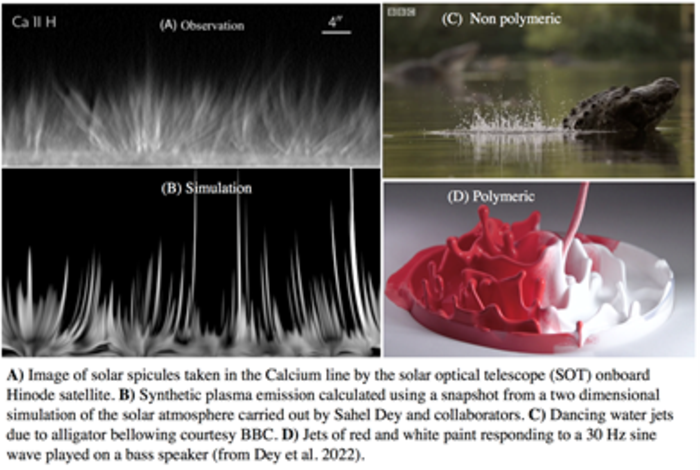Today’s science stories run the gamut of the strange and the weird, with several black holes, the effects of space on astronaut blood cells, and how alligator mating dances added to solar science. Plus, this week’s What’s Up helps you choose binoculars for sky gazing.
Podcast
Show Notes
Black hole swarms merge elliptically
- University of Copenhagen press release
- “AGN as potential factories for eccentric black hole mergers,” J. Samsing et al., 2022 March 9, Nature
Black hole periodically pushes out jets
- NOVA press release
- “Coupling between the accreting corona and the relativistic jet in the microquasar GRS 1915+105,” Mariano Méndez et al., 2022 March 7, Nature Astronomy
Big molecule in baby solar system
- ESO press release
- “A major asymmetric ice trap in a planet-forming disk III. First detection of dimethyl ether,” Nashanty G. C. Brunken et al., 2022 March 8, Astronomy & Astrophysics
Blood cells don’t like space
- NASA press release
- “Hemolysis contributes to anemia during long-duration space flight,” Guy Trudel et al., 2022 January 14, Nature Medicine
Greenland crater far older than thought
- University of Copenhagen press release
- “A Late Paleocene age for Greenland’s Hiawatha impact structure,” Gavin G. Kenny et al., 2022 March 9, Science Advances
Alligator mating calls solve solar puzzle?
- Eötvös Loránd University press release
- “Polymeric jets throw light on the origin and nature of the forest of solar spicules,” Sahel Dey et al., 2022 March 3, Nature Physics
- VIDEO: From alligator mating calls to heavenly dance of the Sun (YouTube)
What’s Up: How to choose a pair of binoculars
- Explore the Moon (RASC)
- Porro Prism vs Roof Prism Binoculars: Which is Best? (Optics Mag)
Transcript
Sometimes, science is just weird, and this is one of those days where weird observations meet weird explanations.
We have black holes a-plenty, with a side of research on astronaut blood and even a bit on how alligators added to solar science.
We told you things are weird.
We also have our much more regular segment of What’s Up that you should go see.
All of this and more is coming at you, right here on the Daily Space.
I am your host Dr. Pamela Gay.
And I am your host Erik Madaus.
And we’re here to put science in your brain.

Since 2015, researchers have had a new tool for studying our universe: gravitational waves. These warps in the space-time continuum are created by high-mass objects closely interacting and giving off energy through these space-changing waves. Thanks to relativity and powerful computers, researchers are able to digitally listen to the ring of these soundwaves and determine the geometry of the merging objects, including both rough estimates of the masses and the shape of their orbit prior to the merger.
Prior to actually being able to measure black hole mergers, researchers assumed that the orbits of merging objects would circularize as they emitted energy in gravitational waves. This is what all the models say should happen and what our observations of other kinds of binaries have demonstrated does happen.
But Nature had other ideas.
In 2019, an object cataloged as GW190521 didn’t look as we expected. Researcher Imre Varos explains: The gravitational wave event GW190521 is the most surprising discovery to date. The black holes’ masses and spins were already surprising, but even more surprising was that they appeared not to have a circular orbit leading up to the merger.
Mysteries are the kind of thing astronomers are compelled to poke at until they are no longer mysteries, and for the past several years, researchers have been working to brainstorm how this could happen. The answer appears to be that you need external forces driving the system.
In our old model, black holes in high-density regions like the cores of galaxies moved in a three-dimensional sphere with a myriad of orbits that rarely interacted, but since we know black holes do interact to have weird mergers, researchers reconfigured galaxies to confine black holes to a disk of material, causing them to move more like billiard balls than juggler’s balls. This forced the black holes to interact more often and for pairs to get pulled into elliptical orbits through interactions with a third object. Lead researcher Johan Samsing adds: We have now shown that there can be a huge difference in the signals emitted from black holes that merge in flat, two-dimensional disks, versus those we often consider in three-dimensional stellar systems, which tells us that we now have an extra tool that we can use to learn about how black holes are created and merge in our Universe.
These results appear in the journal Nature.

Black holes are one of those rare objects that are so weird that they get a whole lot of attention. And when I say they are weird, I mean they gift researchers with utterly unexpected things on a regular basis. In another system, GRS 1915+105, researchers found the system changes over a 500-ish day period in a way they liken to a heart. Located in a binary system, this roughly twelve solar mass black hole steals material from its companion, and that material is excited into a corona around the black hole and driven into jets.
This work is published in Nature Astronomy and was led by Mariano Méndez.
For fifteen years, a team monitored this system with the orbiting Rossi X-ray Timing Explorer and the Ryle radio telescope outside London. In this data, they found a roughly 500-day cycle, with the radio and X-ray data reaching their separate peak brightnesses when the other light was faint.
This was the first time both aspects of a system were so thoroughly observed, and this remarkable data set allowed them to determine that the corona and jets are directly related. According to the paper’s abstract, the system’s X-ray corona can transform into radio jets. This is driven by thermal instabilities.
To try and explain this as simply as possible: material builds up in the corona where it emits X-ray light. At a certain point, this built-up material collapses into jets, the X-ray light goes away, and the radio light brightens, feeding the jets. This reminds me of those water features at amusement parks where water builds up in a bucket until it becomes unstable and flips to dump water all over anyone below.
Black holes do weird things. And this is your lesson for today: do not park your spacecraft below a black hole — it just might get a radio jet dumped on it.

Let’s face it, we’re still learning a whole lot about the details of when and where we find all sorts of different cool events in our galaxy and the universe beyond. While black holes are all kinds of awesome with their weird physics, another area of space science is doing its best to show it can be just as weird in totally different ways.
That area? Solar system formation.
Researchers are working hard to figure out how a blob of gas can, over time, become a star system rich in planets and possibly life. This work is being done in two ways. Folks are working on developing models of what should happen, and folks are looking at solar systems in the process of forming at every possible stage of their development. These observations constrain when different structures form, and by structures, sometimes I mean molecules.
New observations from the Atacama Large Millimeter/submillimeter Array (ALMA) have shown that the molecule dimethyl ether is already present in planet-forming disks. Study co-author Alice Booth remarks: It is really exciting to finally detect these larger molecules in discs. For a while, we thought it might not be possible to observe them… What makes this even more exciting is that we now know these larger complex molecules are available to feed forming planets in the disc. With these molecules present from the very beginning, life – or at least complex organic molecules – had the seeds to start forming from the very start.
This work is published in Astronomy & Astrophysics with lead author Nashanty G.C. Brunken.
From the weird far away, we now turn to the weird here at home, including how alligator roars are helping us understand solar structures. Really.
But first, let’s look at the effects of space on people and space rocks on Greenland.

While your heart and mind may yearn to visit outer space, your red blood cells are not going to be totally ok with this kind of travel. This is the result of a new paper published in Nature Medicine that shows that the volume of red blood cells in astronauts drops due to an increase in red blood cell destruction: a 54% increase in red blood cell destruction.
We need red blood cells; they keep our bodies well-oxygenated, and the more we have the easier it is for our bodies to handle serious exertions and stresses. Without enough oxygen, our brain function gets fuzzy, our muscles don’t work as well, and it’s Just Bad.
While this result is new, we’d long known that astronauts had a lower red blood cell volume. It wasn’t known why. Perhaps optimistically, folks thought it was related to how the microgravity environment of space redistributes liquids in the body.
Nope. The body just destroys red blood cells. Figuring out how to stop that is next on the to-do list, and if they can find a solution for astronauts, hopefully, they will find a solution that also helps all the Earth-bound folks with blood disorders. It’s always nice when out-of-the-world problems can help people here on Earth.
Normally space is just trying to kill us, and speaking of trying to kill us…

In the northwest of Greenland, there is a 31-kilometer impact crater named Hiawatha that has puzzled scientists for years. Dating the giant structure has been difficult, but now it seems that two separate teams of researchers, working with two different methods, have reached the same conclusion about the age of this crater. Rather than the youngish possible age of 13,000 years, the Hiawatha crater is about 58 million years old.
Keep in mind that this rather large impact crater was only discovered in 2015, so it’s not as if we were just wildly wrong for a long time. It’s not easy to see or understand something that is buried under a kilometer of ice after all, so scientists posed several different hypotheses for the crater’s age. That 13,000-year-old possibility would have made the impact responsible for a period of cooling called the Younger Dryas, which lasted 1,000 years.
Instead, it appears that this impact occurred not long after the much larger Chicxulub impact that wiped out the dinosaurs, meaning it would have caused even more problems for an already burdened climate and ecosystem. Not to mention that since this particular region wasn’t covered in an ice sheet at the time of the impact, the local flora and fauna would have been devastated. What we call the Arctic today was then lush, temperate rainforest. Earth just couldn’t catch a break back then, it seems.
To date this impact, a team working out of the Natural History Museum of Denmark heated up grains of sand and analyzed the argon gas that was released. And the Swedish Museum of Natural History used uranium-lead dating on rock samples. Both returned the age of 58 million years. Michael Story from the Denmark group stated: Dating the crater has been a particularly tough nut to crack, so it’s very satisfying that two laboratories in Denmark and Sweden, using different dating methods arrived at the same conclusion. As such, I’m convinced that we’ve determined the crater’s actual age, which is much older than many people once thought.
Next up, the teams intend to work out just what affects the impact had on the climate. This work appears in the journal Science Advances.

Around the same time that a sizable rock created the Hiawatha impact crater in Greenland, alligators and caimans split apart into two different groups. Both groups have continued to exist throughout the millennia, a seeming relic of the time of the dinosaurs. And now, that relic is helping us understand a particular solar feature. No, really.
Let’s start at the beginning. Have you ever watched one of the videos on YouTube that show paint dancing in neat patterns on a speaker? That mechanic is called Faraday excitation, and it was first demonstrated by scientist Michael Faraday way back in 1831 using a plastic membrane in a shallow fluid. And it turns out that a similar dance is occurring in the solar plasma at the surface of the Sun, causing something named ‘spicules’ to appear. But scientists were having a rough time understanding just what caused these spikes on the Sun.
Enter the alligators.
During mating displays, male alligators submerge just below the water’s surface and bellow at bass frequencies that then resonate in the water and cause jets to dance on the surface. And these jets work the same way as paint on a speaker. And they could work the same way as the solar spicules on the Sun.
Per the press release: Essentially, the ubiquitous and well-understood convection in the lower solar atmosphere – analogous to boiling water in a hot pan – serves almost periodic but strong kicks to the plasma in the solar chromosphere, the shallow layer just above the visible solar surface. The material in the chromosphere is 500 times lighter than the photosphere, meaning these strong kicks from the bottom shoot the chromospheric specular plasma outward in the form of elongated jets, between 300-1000 km wide and 5000-30000 km tall.
At any one point in time, there are over three million spicules on the Sun, and this new research, published in Nature Physics, shows that the internal solar convection can be the driving force for the wide variety of heights and speeds seen. This new information can be used to further understand the forces behind the solar wind and the mechanisms for heating the solar corona to millions of Kelvin.
Alligators, paint, and the Sun. Science works in amazing and strange ways, folks.
And now, it’s time to look up as Erik Madaus teaches us to choose and use binoculars for some nighttime sky gazing.
What’s Up

One of the things we try to do with this What’s Up segment is tell you about things you can see with binoculars or the unaided eye rather than just a telescope, but we haven’t really talked about the different types of binoculars useful for astronomy and when you should get one instead of a telescope.
The Royal Astronomical Society of Canada has advice for which type of binoculars to get depending on what you want to see. If your budget is limited, get a good pair of binoculars rather than a cheap telescope because a cheap pair of binoculars will be better than a cheap telescope. Binoculars are also more user-friendly because they have wider fields of view than a telescope and provide the same orientation as your unaided eye, unlike most telescopes. Binoculars also provide a brighter field of view and not just because you use both eyes but because of the bigger entrance pupil (diameter of the light beam that comes out the back), which the low magnification provides.
There is no single binocular type best for astronomy. We’ll get to what the RASC advises for binoculars, but first some terms.
Binoculars are listed by magnification and aperture, for example, 7×50 where 7 is the magnification and 50 is the aperture of each lens. There are other binocular features such as different prism types, Porro vs Roof. Most astronomy binoculars use the Porro prism because it provides a wider field of view and better image quality. It’s also cheaper. Roof prisms are more expensive and have features that are more useful for terrestrial binoculars, like compact size and durability.
Magnifications between 6 and 10 are ideal for scanning the sky, which can help with learning the constellations and other things. This class is also good for comets and large star clusters. Finally, low magnification binoculars can be handheld easier.
Binoculars with higher magnification, between 10 and 20, are more useful for smaller clusters such as the Pleiades and Hyades; however, they are harder to use, and you may need a tripod to use them comfortably, taking away some of the portability. Over about 10 times magnification, it may be easier to use a small telescope with a wide field eyepiece to provide a more comfortable and stable mounting but still get the wide field of view.

Another consideration for a larger pair of binoculars is just how much more you can see with them. Brightness increases as the aperture gets bigger, but brightness decreases as the magnification gets higher. The effect of these two factors is bigger binoculars, those with high magnification and large aperture, let you see dimmer things in more detail because the background will be darker. In general, doubling either the aperture or magnification will let you see four times as much. Sounds pretty obvious, but there is some detail that needs to be taken into account. Bigger optics will be affected more by the sky quality than smaller optics, so depending on your average weather, a smaller-aperture, lower-magnification binocular may outclass a larger one in resolution for your situation.
One upcoming event this month is what’s known as a Messier Marathon. Because of where and how ya boi Charles compiled his list of objects, it is possible to see all 110 objects in a single night from mid-March to April. Depending on your stamina, it may take you a few nights to get all of them in, and you may not get to all of them at all. That’s fine too; astronomy is a hobby, and you shouldn’t burn yourself out trying a challenge if you aren’t ready for it.
The Royal Astronomical Society of Canada has an observing program dedicated to the Moon for both binoculars and telescopes, and you don’t need to be a member to download it. The binocular edition has forty features to look for, and the telescope edition has one hundred. We’ll have a link to it in the show notes for this episode.
So grab some binoculars and a sky map or three, head outside, and look up.
This has been the Daily Space.
You can find more information on all our stories, including images, at DailySpace.org. As always, we’re here thanks to the donations of people like you. If you like our content, please consider joining our Patreon at Patreon.com/CosmoQuestX.
Credits
Written by Pamela Gay, Beth Johnson, and Erik Madaus
Hosted by Pamela Gay, Beth Johnson, and Erik Madaus
Audio and Video Editing by Ally Pelphrey
Content Editing by Beth Johnson
Intro and Outro music by Kevin MacLeod, https://incompetech.com/music/


 We record most shows live, on Twitch. Follow us today to get alerts when we go live.
We record most shows live, on Twitch. Follow us today to get alerts when we go live.